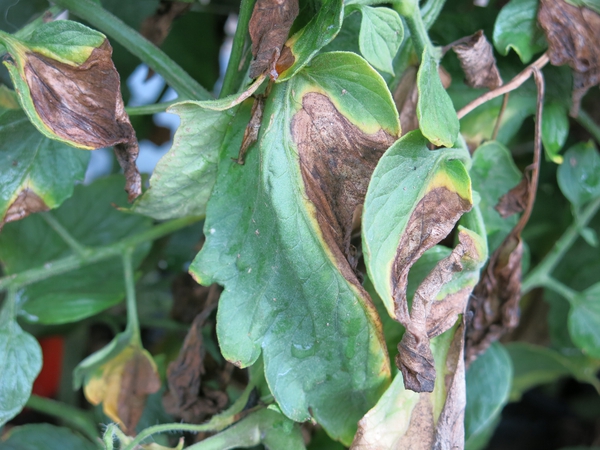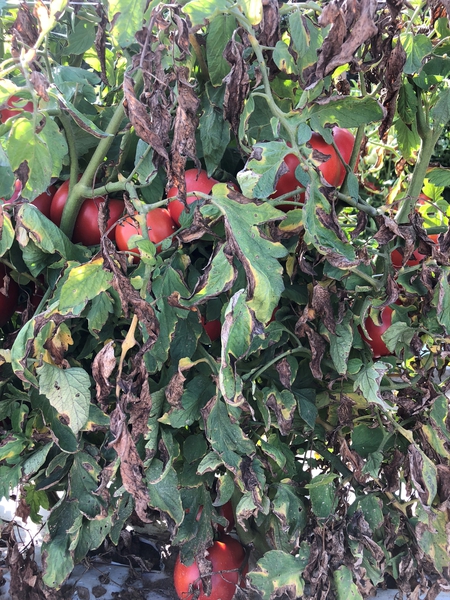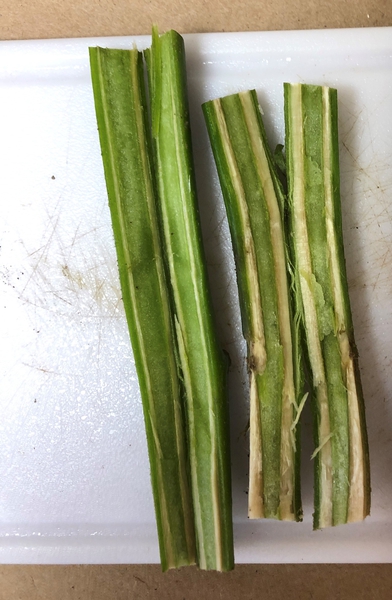Pathogen
Verticillium wilt is caused by two different species of a soilborne fungus: Verticillium albo-atrum and Verticillium dahliae.
Symptoms
Initial symptoms of Verticillium wilt include yellowing of the lower leaves, wilting, stunted growth, and v-shaped lesions that extend inward from the margin of the leaf. Brown, necrotic tissue begins to develop within the lesions as the disease progresses. Symptoms of wilting may only occur late in the season or once the disease is advanced. Because the pathogen affects the vascular tissue (water and nutrient conducting vessels). Plants may wilt in the afternoon when they are actively transpiring and appear to "recover" in the morning, only to wilt again. Lower leaves will begin to die and fall off, eventually leading to plant death. Similar to Fusarium wilt, longitudinal light brown to cream colored streaks can be seen underneath the outside stem tissue and are most prominent at the base of the plant. Vascular streaking can also be observed in the leaves, and this is a characteristic symptom of Verticillium wilt. Plants that do persist in spite of infection will have greatly reduced fruit yields.
Look alike diseases: Lack of moisture or symptoms of other wilt diseases including bacterial wilt, Fusarium wilt, and southern blight may be confused with symptoms of Verticillium wilt. However, V-shaped leaf lesions are distinctive of Verticillium wilt.
Disease Cycle and Epidemiology
Ideal conditions for Verticillium wilt include cooler weather (75 to 85 ⁰F) and neutral to alkaline soil (pH of 7 to 9). The pathogen can survive in the soil without a host for up to 10 years in the form of structures called microsclerotia that are able to withstand drought and cold temperatures. The root exudates of the host trigger germination of these structures in the soil. Openings or wounds in the roots caused by cultivation, secondary root formation, or plant parasitic nematode feeding allow for pathogen entry and infection. Eventually, fungal growth blocks the vascular tissue, inhibiting the transport of water and nutrients to the rest of the plant and causing yellowing, wilting, and eventual plant death.
Distribution and Host Range
Verticillium wilt is a widespread and common disease that affects more than 300 host families. Severely affected plants include tomatoes, eggplant, potatoes, and peppers. However, plants within the Brassicaceae (Brussels sprouts, cabbage, and cauliflower), Cucurbitaceae (cucumber and pumpkin), and Fragariaceae (strawberries) families are susceptible, as well. Additionally, asymptomatic weedy hosts can spread and maintain populations of the fungus. Disease primarily spreads through root colonization.
General Disease Management
Once plants are infected with Verticillium wilt it is impossible to eradicate disease with treatment. Preventative measures to inhibit disease introduction are the most effective options.
- Select resistant varieties. Planting resistant varieties will help inhibit severe symptoms of disease. See the Southeastern US Vegetable Crop Handbook for a list of varieties with resistance. However, widespread deployment of resistant varieties has led to the development of pathogen races that can overcome resistance. If a variety that is resistant to Verticillium wilt has been deployed and symptoms are still observed, then non-race 1 strains are likely to be present for which there is no known resistance at this time.
- Incorporate crop rotations. Rotating to non-host plants at 4-5 year intervals is advised for disease control. The wide host range of the Verticillium wilt pathogen may limit possible rotational crops, but non-susceptible grass and wheat species are recommended.
- Discard infected plant material. The fungus can survive for extended periods of time within plant tissue. The immediate removal of infected plants is necessary to discourage the persistence of the pathogen, if possible.
- Soil solarization. Heating the top six inches of soil to high temperatures for an extended period of time can kill the fungus and reduce the number of infected plants. However, this practice is difficult to implement in the southeastern US because it must be done during summer months. Frequent rainfall and cloudy days make it difficult to maintain the high temperatures needed to be successful.
- Sanitize equipment and tools. Tractors and other equipment that travel between fields should be cleaned frequently to avoid transport of infected soil. Rinse pots and tools thoroughly with water and treat for at least 30 seconds in a 10% bleach solution or 70% alcohol.
- Grow early-maturing varieties. Quickly-maturing crops are likely to begin producing fruit before they completely succumb to disease. This can improve fruit yield in fields with a history of Verticillium wilt.
- Control weeds. Asymptomatic weedy plants can spread disease to susceptible crops. Fields should be frequently and diligently maintained.
- Use mulch from resistant trees. Mulch used from susceptible trees may introduce Verticillium wilt. Conifers, beech, hickory, white oak, and poplar trees are resistant to this disease and a safer source of mulch.
Disease Management for Conventional Growers
There is no cure for Verticillium wilt once a plant has been infected. The preventative measures listed above should be implemented to discourage the introduction of disease. However, soil fumigants such as chloropicrin and metam sodium can reduce the amount of pathogen present in the soil if applied before planting. See the 2021 Southeastern US Vegetable Crop Handbook for effective fumigants and their application.
Disease Management for Organic Growers
Following the suggestions listed in the General Disease Management section will be the most effective way to prevent Verticillium wilt. There are no organic treatments that can eradicate disease once introduced into an area. Providing ample amounts of nutrients and water may encourage certain plants to persist in spite of infection.
Additional Resources
- The NCSU Plant Disease and Insect Clinic provides diagnostics and control recommendations.
- The NC State Extension Plant Pathology Portal provides information on crop disease management.
- The Southeastern US Vegetable Crop Handbook provides information on vegetable disease management.
Publication date: June 22, 2021
N.C. Cooperative Extension prohibits discrimination and harassment regardless of age, color, disability, family and marital status, gender identity, national origin, political beliefs, race, religion, sex (including pregnancy), sexual orientation and veteran status.




